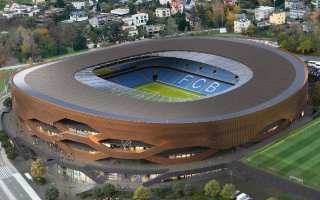Nové Bazaly
| Capacity | 20 000 |
|---|---|
| Country | Czech Republic |
| City | Ostrava |
| Clubs | Baník Ostrava |
| Category | Design awaiting implementation |
| Cost | CZK 2.5 B ($118 M) |
| Construction | 2029–2031 |
| Design | L35 Arquitectos |
Advertisement
Nové Bazaly – design description
How can the new Bazaly Stadium project be summarized?
The Bazaly Stadium served Baník Ostrava for over half a century, but in 2015 the club left the outdated venue and moved to the renovated City Stadium in Ostrava-Vítkovice.
The move was not welcomed by everyone, especially since the Vítkovice ground includes an athletics track, and the relocation meant moving from Baník’s traditional Silesian part of Ostrava to the Moravian side of the city.
In 2023, the city began preparing plans for a modern, football-specific stadium on the site of the old Bazaly, allowing Baník to return to its historic home. Renowned architectural studios from around the world entered the design competition, and the winning project was announced in November 2025.
The new venue will hold around 20,000 spectators and rank among the best in the Czech Republic. Its rust-colored metal facade will reflect the city’s industrial heritage, while hexagonal motifs will reference the basalt once quarried at the site – from which the stadium takes its name.
According to the schedule, construction is expected to begin in 2029 and be completed by the end of 2031.
What does the Bazaly Stadium look like today?
Bazaly Stadium was inaugurated in 1959. It was built on the site of a former basalt quarry – which is also where the stadium’s name originates. For more than fifty years, the ground served Baník Ostrava and witnessed the club’s greatest successes.
In 2013, the stadium was purchased by the city, effectively saving Baník from bankruptcy. As the facility’s condition continued to deteriorate, the club moved in 2015 to the newly renovated City Stadium in Ostrava-Vítkovice.
Between 2018 and 2019, Bazaly underwent redevelopment, reducing its capacity to just 450 seats. Since then, it has served primarily as a training base and for youth teams. In 2022, it hosted several matches of the UEFA Women’s Under-19 Championship.
Why isn’t the City Stadium in Ostrava-Vítkovice an ideal home for Baník?
After its modernization, the City Stadium in Ostrava-Vítkovice meets all required standards, including those allowing it to host European competitions. However, the presence of an athletics track means that the stands are set some distance away from the pitch, which prevents the venue from offering the atmosphere typical of football-specific stadiums.
Another drawback is its location in the Moravian part of Ostrava. Although Baník is now regarded as a club representing the entire city, its roots lie on the Silesian side, across the Ostravice River – where the Bazaly Stadium is located.
How did the new Bazaly project come about?
In 2023, the city authorities began expressing their intention to restore Bazaly’s role as Baník’s main stadium. In 2024, the city commissioned a preliminary feasibility study for the potential reconstruction of the Bazaly Stadium. The study, along with conceptual visualizations, was prepared by David Kotek and Rudolf Müller of the architectural practice Projektstudio.
In June 2024, a memorandum on the construction of the new stadium was signed between the city, FC Baník and its academy, the Football Association of the Czech Republic (FAČR), and the company Vítkovice Aréna, which manages the Bazaly site on behalf of the city. Shortly thereafter, the city established a working group tasked with preparing the project.
In March 2025, another memorandum was signed, this time with FAČR only, expressing the intention to host matches of the Czech national football team at the new Bazaly Stadium.
When was the architectural competition for the new Bazaly held?
At the end of 2024, the city announced a competition for the architectural concept of the new Bazaly Stadium. A total of 29 teams submitted entries, including renowned international practices such as Populous, Zaha Hadid Architects, HOK, Arup, IDOM, and Fenwick Iribarren Architects.
In February 2025, the shortlist was reduced to ten design teams (nine of which went on to submit final proposals), and by May, four finalists were selected for the final round.
The winning concept for the new Bazaly Stadium was announced on November 4, 2025, following its approval by the City Council. The official presentation of the visualizations took place the same day on the footbridge near the old Bazaly site.
The winner was chosen unanimously by a nine-member jury. The design was prepared by the Barcelona-based practice L35 Arquitectos, previously responsible, among others, for the redevelopment project of the Santiago Bernabéu Stadium.
What does the new Bazaly design include?
The project envisions the construction of a modern, football-specific stadium on the site of the old Bazaly ground. The training pitches located south of the main field will be retained, while the adjacent Českobratrská Street will be narrowed to two lanes to create additional space. A new roundabout is also planned near the main stand.
At the base of the structure, a raised platform with a promenade will encircle the stadium. The upper levels will be wrapped in a perforated metal facade with a rusty hue. The stands will be covered by a slightly concave roof, giving the building a cohesive and unified form.
The architecture of the new Bazaly will combine two symbolic themes: Ostrava’s industrial heritage – particularly its mining and steelmaking traditions – and the local history of the site, where basalt was once quarried. The city’s industrial character is reflected in the metal facade, while the dark base and hexagonal motifs evoke the basalt rock formations.
The most prominent feature will be the western facade, facing the city centre and clearly visible from landmarks such as the Town Hall tower. With its striking form and location, the new stadium is expected to become one of Ostrava’s most distinctive architectural landmarks. On the eastern side, the building will be partially embedded into the slope, giving it a more modest appearance.
The stadium will accommodate around 20,000 spectators and be built to a high standard, featuring premium hospitality suites, modern amenities, and sustainability-focused solutions. It will also include a club store and museum. Upon completion, it is expected to rank among the most advanced football venues in the Czech Republic.
Inside the complex, over 500 parking spaces will be provided, though most supporters are expected to arrive by public transport or on foot.
When will the new Bazaly Stadium be built?
The full design documentation is scheduled to be prepared in 2026. The following years, 2027–2028, will be dedicated to obtaining the necessary permits and selecting the main contractor. Construction of the stadium is expected to begin in 2029 and be completed by the end of 2031.
The investment is estimated to cost CZK 2.5 billion. The project was initiated by the city, which will most likely bear the majority of the expenses, although contributions from the club and other partners are also anticipated. The Moravian-Silesian Region has pledged to cover 10% of the total cost.
Advertisement
Renderings
-
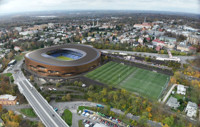
2025 © L35 Arquitectos 
2025 © L35 Arquitectos 
2025 © L35 Arquitectos 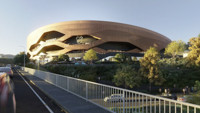
2025 © L35 Arquitectos 
2025 © L35 Arquitectos 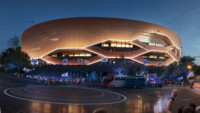
2025 © L35 Arquitectos 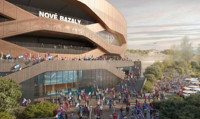
2025 © L35 Arquitectos 
2025 © L35 Arquitectos 
2025 © L35 Arquitectos

 StadiumDB
StadiumDB